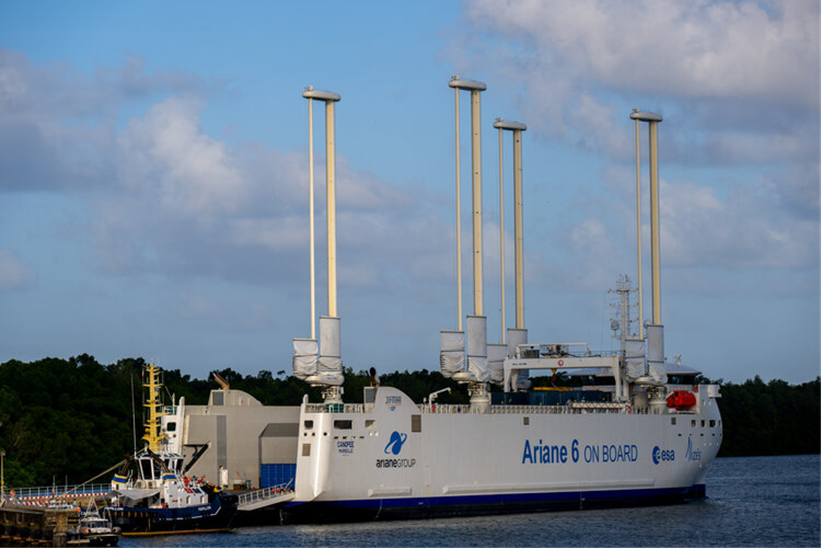Ariane 6 unloaded in French Guiana
February 23, 2024

The central core of European Space Agency’s (ESA) giant Ariane 6 rocket has arrived in French Guiana, shipped from France on ESA’s own specialised vessel, Canopée.
In time for its summer test-launch this year, Ariane 6 has arrived at the port of Pariacabo in Kourou, French Guiana – home of Europe’s Spaceport – and is ready to be assembled at the Kourou Spaceport.
All the elements that make up the rocket are manufactured in mainland Europe and then transported by this novel ship, Canopée (canopy in French). It is the first custom-built transporter to use sails, reducing emissions and saving on fuel by up to 30 per cent, and on this trip, it has travelled for 10 days covering over 7,000 km from Le Havre, France.
The hybrid-propulsion vessel is 121m long and has 37m tall sails. Canopée travels continuously between France and French Guiana to load each Ariane 6 stage and other parts and ship them across the Atlantic Ocean to Europe’s spaceport.
On this trip, Canopée brings the central core for Ariane 6’s first flight. Having collected the upper stage from Bremen, Germany, Canopée moved on to Le Havre, France, to load the main stage of Ariane 6. The main stage was constructed in Les Mureaux, France, at ArianeGroup’s assembly hall.
The next-generation cargo ship has been designed for ArianeGroup to meet the complex requirements of Ariane 6 transport – the stages and engines of Ariane 6 are high-tech equipment that require delicate care during transport.
Canopée’s structure is designed to carry large, fragile loads as well as navigate the shallow Kourou river to Pariacabo harbour. From here the various Ariane 6 components are offloaded and transported by road to the new Ariane 6 launch vehicle assembly building just a few kilometres away.
Once upright, two boosters will be added for Ariane 6’s first test flight (they are already in French Guiana). Lastly, the upper composite fairing – a nosecone that splits vertically in two – and the payloads will be attached on the launch pad.
Other posts by Chris Forrester:
- Intelsat C-band ‘insider trading’ case dismissed
- UK Space Agency funds de-orbit scheme for OneWeb
- AST SpaceMobile to launch satellites in August
- SpaceRISE silent on reports of demise
- Project Kuiper seeks India licence
- FAA suspends SpaceX launches
- SpaceX vs AST SpaceMobile
- Eumetsat explains Ariane 6 cancellation
- AST SpaceMobile examines emergency call obligations
